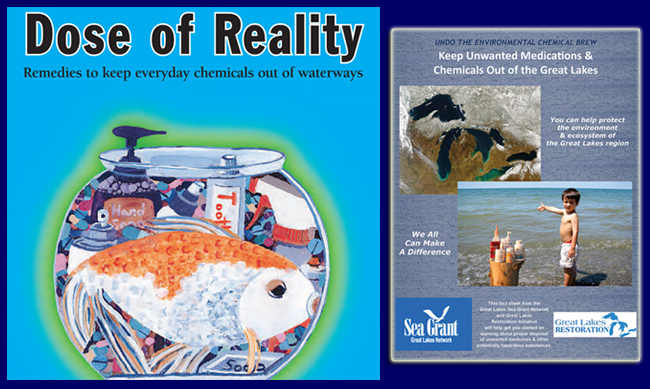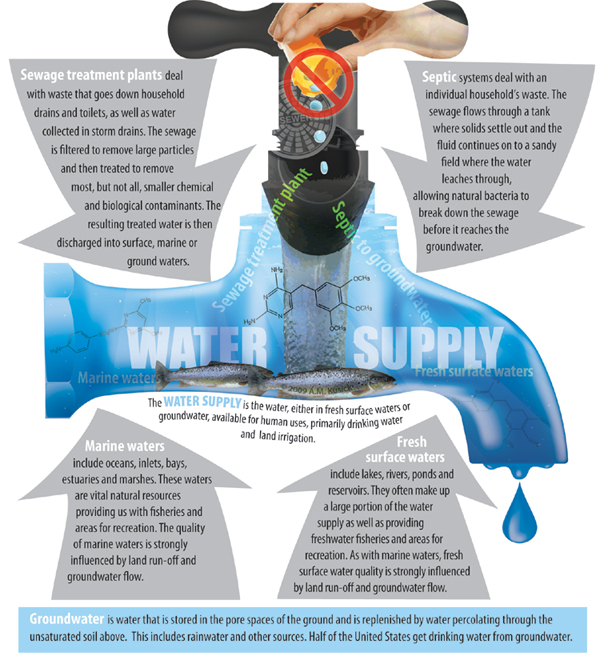Contact:
Helen Domske, NY Sea Grant's Coastal Education Specialist, P: 716.645.3610, E: hmd4@cornell.edu
Buffalo, NY, October 13, 2016 - New York Sea Grant is reminding Great Lakes residents that October 22, 2016, is a National Prescription Drug Take Back Day for dropping off unused medicines at collection sites statewide. The goal is to keep the pharmaceuticals out of the freshwater Great Lakes system that provides drinking water to 42 million people in the United States and Canada.
"The simple act of dropping off your unused prescription drugs at a nearby collection point helps reduce the impact of such substances as antibiotics, hormones, contraceptives, antidepressants, cosmetics, and vitamins on the aquatic environment and on human health," says New York Sea Grant Coastal Education Specialist Helen Domske.
More than 350 tons of prescription drugs were dropped off at more than 8,000 sites across the U.S. on the Fall 2015 collection day.
To locate an authorized National Prescription Drug Take Back collection for the October 22, 2016 collection, visit the U.S. DEA National Take Back Day Initiative Web site. Collection hours are 10 am to 2 pm.
What You Can Do
How can you get rid of your old medicines this Saturday? Visit the National Take Back Initiative Collection Site Search
to punch in your zip code and find an authorized drug disposal site
near you. Additional information on the Take Back days can be found at USDEA's National Take Back Initiative's Web site.
The U.S Food and Drug Administration provided a comprehensive list of drugs that it recommends for disposal via the sink or toilet.
In addition to Sea Grant's "Return Unwanted Medicines" resources, our program offers a number of other "Great Tips for Coastal Living."
Sea Grant's Research & Education Efforts on Pharmaceuticals in our Waterways

Domske is a 2016 Western New York Distinguished Scientist and author of the Undo the Environmental Chemical Brew: Keep Unwanted Medications and Chemicals Out of the Great Lakes guide with tips on how citizens can keep unwanted pharmaceuticals and personal care products out of Great Lakes waters. Find more information online at www.nyseagrant.org/unwantedmeds.
Research by New York Sea Grant and other science organizations has tracked the feminization of fish populations downstream from wastewater treatment plants to estrogen and its components found in prescription drugs.
A New York Sea Grant-funded, two-year research project that began in February 2016 is examining the effectiveness of advanced water treatment options, environmental levels and potential effects of pharmaceuticals in New York waters. Stony Brook University research Anne McElroy noted earlier this year, ‘The number of pharmaceutically-active ingredients (API) and their known or suspected active metabolites in coastal waters is in the hundreds and continues to increase. Data collected from our project will help to fill important data gaps and enhance knowledge about sewage-derived APIs and their effects on fish behavior and how well advanced wastewater treatment technologies reduce API discharges and mitigate these effects.’
The biannual National Prescription Drug Take Back Days are an initiative of the U.S. Drug Enforcement Agency in cooperation with law enforcement agencies nationwide.

When pharmaceuticals are flushed, they enter household septic systems or
sewage treatment plants and can make their way into our waterways or
even water supply. Follow the diagram to see how. Information courtesy
of Stony Brook University (SBU) School of Marine and Atmospheric
Sciences researcher Dr. Henry Bokuniewicz and SBU graduate student Ruth
Coffey. Illustration by Anita Kusick.
More Info: New York Sea Grant
New York Sea Grant (NYSG), a cooperative program of Cornell University
and the State University of New York, is one of 33 university-based
programs under the National Sea Grant College Program (NSGCP) of the
National Oceanic and Atmospheric Administration (NOAA). The NSGCP
engages this network of the nation’s top universities in conducting
scientific research, education, training and extension projects designed
to foster science-based decisions about the use and conservation of our
aquatic resources. Through its statewide network of integrated
services, NYSG has been promoting coastal vitality, environmental
sustainability, and citizen awareness about the State’s marine and Great
Lakes resources since 1971.
New York Sea Grant maintains Great Lakes offices at SUNY Buffalo, the
Wayne County Cooperative Extension office in Newark and at SUNY Oswego.
In the State's marine waters, NYSG has offices at Stony Brook University
and Stony Brook Manhattan, in the Hudson Valley through Cooperative
Extension in Kingston and at Brooklyn College.
For updates on Sea Grant activities: www.nyseagrant.org has RSS, Facebook, Twitter, and YouTube links. NYSG also offers a free e-list sign up via www.nyseagrant.org/coastlines for its flagship publication, NY Coastlines/Currents, which is published several times a year.